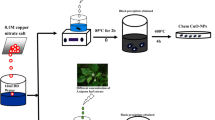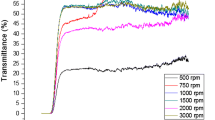Abstract
Six crimson samarium (III) complexes based on β-ketone carboxylic acid and ancillary ligands were synthesized by adopting the grinding technique. All synthesized complexes were investigated via elemental analysis, infrared, UV–Vis, NMR, TG/DTG and photoluminescence studies. Optical properties of these photostimulated samarium (III) complexes exhibit reddish-orange luminescence due to 4G5/2 → 6H7/2 electronic transition at 606 nm of samarium (III) ions. Further, energy bandgap, color purity, CIE color coordinates, CCT and quantum yield of all complexes were determined accurately. Replacement of water molecules by ancillary ligands enriched these complexes (S2-S6) with decay time, quantum yield, luminescence, energy bandgap and biological properties than parent complex (S1). Interestingly, these efficient properties of complexes may find their applications in optoelectronics and lighting systems. In addition to these, the antioxidant and antimicrobial assays were also investigated to explore the applications in biological assays.











Similar content being viewed by others
Data Availability
All data analyzed during this study are included in this article and its supplementary information.
Code Availability
No software or any computational study was not used for this study.
References
Khatkar SP, Kumar R, Khatkar A, Taxak VB (2015) Synthesis, characterization, enhanced photoluminescence and biological activity of Eu (III) complexes with organic ligands. J Mater Sci Mater Electron 26:7086–7095
Khanagwal J, Khatkar SP, Dhankhar P et al (2020) Synthesis and photoluminescence analysis of europium (III) complexes with pyrazole acid and nitrogen containing auxiliary ligands. Spectrosc Lett 53:625–647
Liu Y, Tu D, Zhu H, Chen X (2013) Lanthanide-doped luminescent nanoprobes: controlled synthesis, optical spectroscopy, and bioapplications. Chem Soc Rev 42:6924–6958
Wang D, Zheng C, Fan L et al (2014) Photoluminescence behavior of europium (III) complexes containing 1-(4-tert-butylphenyl)-3-(2-naphthyl)-propane-1, 3-dione ligand. Spectrochim Acta Part A Mol Biomol Spectrosc 117:245–249
Refat MS, El-Hawary WF, Moussa MAA (2011) IR, 1H NMR, mass, XRD and TGA/DTA investigations on the ciprofloxacin/iodine charge-transfer complex. Spectrochim Acta Part A Mol Biomol Spectrosc 78:1356–1363
Taxak VB, Khatkar SP (2012) Synthesis and Luminescent Properties of M 2 V 2 O 7: Eu (M= Sr, Ba) Nanophosphors. J Fluoresc 22:891–897
Leonzio M, Melchior A, Faura G et al (2018) A chiral lactate reporter based on total and circularly polarized Tb (III) luminescence. New J Chem 42:7931–7939
Devi R, Chahar S, Khatkar SP et al (2017) Relative study of luminescent properties with Judd-Ofelt characterization in trivalent europium complexes comprising ethyl-(4-fluorobenzoyl) acetate. J Fluoresc 27:1349–1358
Chahar S, Taxak VB, Dalal M et al (2016) Structural and photoluminescence investigations of Sm3+ doped BaY2ZnO5 nanophosphors. Mater Res Bull 77:91–100
Zhang Z, Tang R (2012) Synthesis and fluorescence properties of Tb (III) complex with a novel β-diketone ligand as well as spectroscopic studies on the interaction between Tb (III) complex and bovine serum albumin. J Mol Struct 1010:116–122
Kumar R, Boora P, Khatkar A et al (2016) Synthesis, photoluminescence and biological properties of terbium (III) complexes with hydroxyketone and nitrogen containing heterocyclic ligands. Spectrochim Acta Part A Mol Biomol Spectrosc 152:304–310
Sarıoğlu AO, Yalçın ŞP, Ceylan Ü et al (2020) Photoluminescence properties of samarium (III)-based complexes: Synthesis, characterization and single crystal X-ray. J Lumin 227:117537
Kumar R, Makrandi JK, Singh I, Khatkar SP (2008) Preparation and photoluminescent properties of europium complexes with methoxy derivatives of 2′-hydroxy-2-phenylacetophenones. J Lumin 128:1297–1302
Kassim NK, Lim PC, Ismail A, Awang K (2019) Isolation of antioxidative compounds from Micromelum minutum guided by preparative thin layer chromatography-2, 2-diphenyl-1-picrylhydrazyl (PTLC-DPPH) bioautography method. Food Chem 272:185–191
Rieckmann KH, Sax LJ, Campbell GH, Mrema JE (1978) Drug sensitivity of P. falciparum. An in vitro microtechnique Lancet 1:22–23
Hooda P, Taxak VB, Malik RK et al (2021) Designing of emerald terbium (III) ions with β‐ketocarboxylic acid and heterocyclic ancillary ligands for biological and optoelectronic applications. Luminescence
Perkampus H (1976) LJ Bellamy: The Infrared Spectra of Complex Molecules, Vol. 1, 3. Auflage, Chapman and Hall Ltd., London 1975, 433 Seiten, 32 Abb., 22 Tabellen, Preis:£ 8.—.
Khanagwal J, Kumar R, Hooda P et al (2021) Designing of luminescent complexes of europium (III) ion with hydroxyl ketone and nitrogen donor secondary ligands for improving the luminescence performance and biological actions. Inorganica Chim Acta 525:120463
Refat MS (2007) Synthesis and characterization of norfloxacin-transition metal complexes (group 11, IB): spectroscopic, thermal, kinetic measurements and biological activity. Spectrochim Acta Part A Mol Biomol Spectrosc 68:1393–1405
Bala M, Kumar S, Chahar S et al (2020) Synthesis, NMR and optical features of intense green color terbium (III) complexes. Optik (Stuttg) 202:163636
Al-Omar MA (2005) Ciprofloxacin: analytical profile. In: Profiles of Drug Substances, Excipients and Related Methodology. Elsevier, pp 179–207
Skauge T, Turel I, Sletten E (2002) Interaction between ciprofloxacin and DNA mediated by Mg2+-ions. Inorganica Chim Acta 339:239–247
Bala M, Kumar S, Devi R et al (2018) Synthesis and photoluminescence properties of europium (III) complexes sensitized with β-diketonato and N, N-donors ancillary ligands. Spectrochim Acta Part A Mol Biomol Spectrosc 196:67–75
Wang X, Yue Y, Zhang Y et al (2019) Probing the interaction of pepsin with imidacloprid via DFT calculation, spectroscopic approaches and molecular docking. J Mol Struct 1197:210–216
Khanagwal J, Kumar R, Devi R et al (2021) Photoluminescence performance of green light emitting terbium (III) complexes with β-hydroxy ketone and nitrogen donor ancillary ligands. Luminescence 36:742–754
Sadeek SA, El-Shwiniy WH, Zordok WA, El-Didamony AM (2011) Spectroscopic, structure and antimicrobial activity of new Y (III) and Zr (IV) ciprofloxacin. Spectrochim Acta Part A Mol Biomol Spectrosc 78:854–867
Phogat P, Khatkar SP, Malik RK et al (2021) Crystal chemistry and photoluminescent investigation of novel white light emanating Dy3+ doped Ca9Bi (VO4) 7 nanophosphor for ultraviolet based white LEDs. Mater Chem Phys 124828
Sehrawat P, Khatkar A, Boora P et al (2020) Tailoring the tunable luminescence from novel Sm3+ doped SLAO nanomaterials for NUV-excited WLEDs. Chem Phys Lett 755:137758
Khanagwal J, Kumar R, Bedi M et al (2021) Enhanced Optoelectronic and Biological Potential of Virescent-Glowing Terbium (III) Complexes with Pyrazole Acid. J Electron Mater 50:2656–2668
Bedyal AK, Kumar V, Ntwaeaborwa OM, Swart HC (2014) A promising orange-red emitting nanocrystalline NaCaBO3: Sm3+ phosphor for solid state lightning. Mater Res Express 1:15006
Devi S, Khatkar A, Taxak VB et al (2018) Optical properties of trivalent samarium-doped Ba5Zn4Y8O21 nanodiametric rods excitable by NUV light. J Alloys Compd 767:409–418
Hooda A, Khatkar SP, Khatkar A et al (2019) Crystal structure, synthesis and photoluminescent properties of a reddish-orange light emitting SrGdAlO4: Sm3+ nanophosphor. Mater Chem Phys 232:39–48
Yan B, Song YS (2004) Spectroscopic study on the photophysical properties of lanthanide complexes with 2, 2′-bipyridine-N, N′-dioxide. J Fluoresc 14:289–294
Parker D (2000) Luminescent lanthanide sensors for pH, pO2 and selected anions. Coord Chem Rev 205:109–130
Chauhan A, Langyan R (2020) Preparation and optical features of samarium (III) complexes introducing bidentate fluorinate and secondary ligands. J Mater Sci Mater Electron 31:22085–22097
Nandal P, Kumar R, Khatkar A et al (2016) Synthesis, characterization, enhanced photoluminescence, antimicrobial and antioxidant activities of novel Sm (III) complexes containing 1-(2-hydroxy-4, 6-dimethoxyphenyl) ethanone and nitrogen containing ancillary ligands. J Mater Sci Mater Electron 27:878–885
Nandal P, Kumar R, Sheetal SP, Taxak VB (2018) Preparation, Photoluminescent Behaviour, Antimicrobial and Antioxidant Properties of New Orange Light Emitting Sm (III) Complex, Sm (CHME) 3. Dmphen
Chauhan A, Malik RK, Lohra S, Langyan R (2021) Investigation of photophysical properties of ternary Sm (III) complexes. Optik (Stuttg) 242:167078
Chauhan A, Langyan R (2021) Preparation, characterization and luminescence behavior of some samarium complexes. Rare Met 40:2618–2626
Dar WA, Ganaie AB, Iftikhar K (2018) Synthesis and photoluminescence study of two new complexes [Sm (hfaa) 3 (impy) 2] and [Eu (hfaa) 3 (impy) 2] and their PMMA based hybrid films. J Lumin 202:438–449
Räsänen M, Takalo H, Rosenberg J et al (2014) Study on photophysical properties of Eu (III) complexes with aromatic β-diketones–Role of charge transfer states in the energy migration. J Lumin 146:211–217
Latva M, Takalo H, Mukkala V-M et al (1997) Correlation between the lowest triplet state energy level of the ligand and lanthanide (III) luminescence quantum yield. J Lumin 75:149–169
Liu J-Y, Ren N, Zhang J-J, Zhang C-Y (2013) Preparation, thermodynamic property and antimicrobial activity of some rare-earth (III) complexes with 3-bromo-5-iodobenzoic acid and 1, 10-phenanthroline. Thermochim Acta 570:51–58
Acknowledgements
One of the authors, Pooja Hooda gratefully acknowledges the Department of Chemistry, Maharshi Dayanand University Rohtak for providing instrumental facilities.
Funding
Pooja Hooda, One of these authors appreciates the financial support from the Council of Scientific and Industrial Research (CSIR) in New Delhi, India in form of a senior research fellowship (SRF) (Award No: 09/382(0207)/2019-EMR-I) to complete this research work.
Author information
Authors and Affiliations
Contributions
Pooja Hooda performed experimental works, data collection, analysis, validation, interpretation and wrote the original manuscript. Savita Khatri and Poonam Kumari contributed to the experimental, reviewed and edited manuscript. V. B. Taxak, R. K. Malik, S. P. Khatkar, and Rajesh Kumar contribute to supervision, technical support, editing functions and manuscript review.
Corresponding author
Ethics declarations
Ethics Approval/Declarations
Not Applicable.
Consent to Participate
Not Applicable.
Consent for Publication
Not Applicable.
Conflicts of Interest/Competing Interests
The authors say no conflicts of interest regarding this research work.
Additional information
Publisher's Note
Springer Nature remains neutral with regard to jurisdictional claims in published maps and institutional affiliations.
Supplementary Information
Below is the link to the electronic supplementary material.
Rights and permissions
About this article
Cite this article
Hooda, P., Taxak, V.B., Malik, R.K. et al. Applicability of Reddish-Orange Light Emitting Samarium (III) Complexes for Biomedical and Multifunctional Optoelectronic Devices. J Fluoresc 32, 613–627 (2022). https://doi.org/10.1007/s10895-021-02887-x
Received:
Accepted:
Published:
Issue Date:
DOI: https://doi.org/10.1007/s10895-021-02887-x




